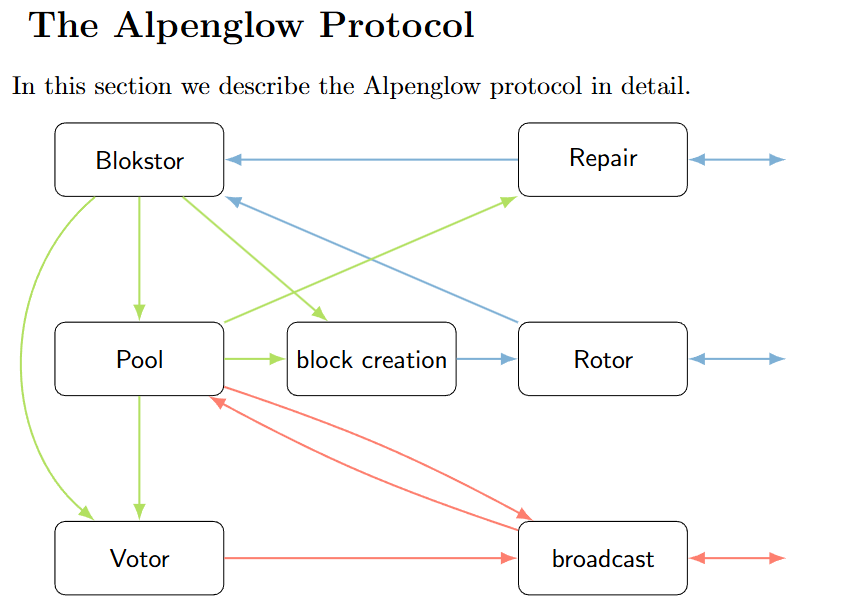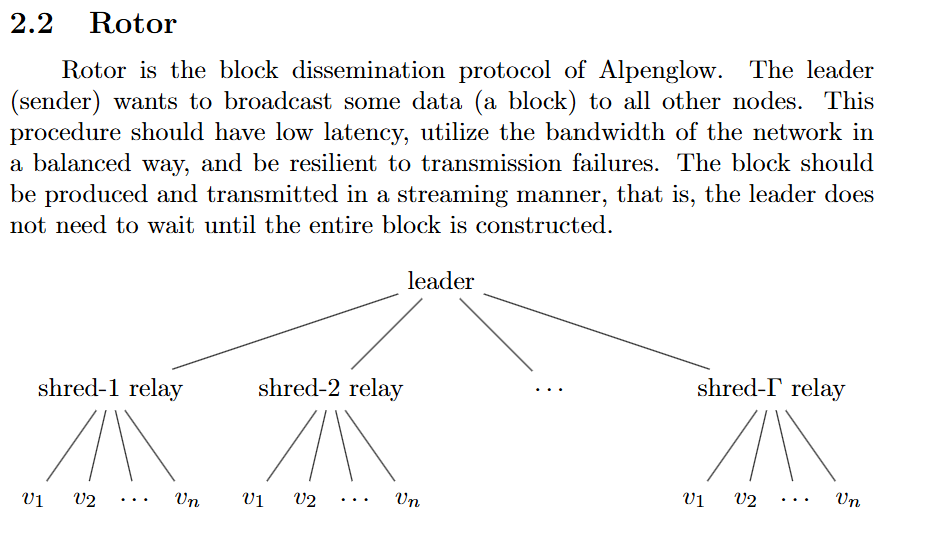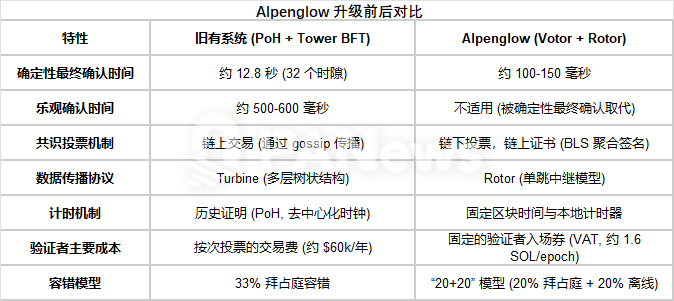Author: Frank, PANews
Although not widely noticed, the Solana network has successfully undergone an important consensus and performance upgrade as scheduled.
On September 1, the Alpenglow proposal (SIMD-0326) for the Solana network was officially passed through community voting. The core achievement of this upgrade is to reduce the network's deterministic block finalization time from the original approximately 12.8 seconds to a target range of 100-150 milliseconds. However, Alpenglow is not merely a simple parameter adjustment and optimization; it represents a reconstruction of the consensus layer of the Solana network. The implications behind it extend far beyond performance improvements, potentially leading to comprehensive changes in Solana's consensus mechanism, economic model, and future development direction. In short, the far-reaching impact of this transformation will radiate throughout the entire ecosystem.
Compressing Final Confirmation Time from 13 Seconds to 150 Milliseconds, but Not Just Speeding Up
Alpenglow is a new consensus protocol proposal for Solana. It was officially introduced by Anza at the Solana Accelerate conference in New York in May. Anza is the team behind Solana's main validator client, Agave, as well as several tools and key infrastructure upgrades on the network over the past few years.
The core of Alpenglow lies in reconstructing Solana's consensus mechanism to achieve a significant enhancement in network performance. Due to the changes in the consensus mechanism, it also impacts the entire network's economic model structure.

Technically, Alpenglow has two core components: the new finality engine, Votor, and the high-performance data propagation layer, Rotor.
Before understanding the significant changes brought by these components, we may need to review Solana's current consensus system, which is primarily composed of Proof of History (PoH) and Tower BFT. Under the current system, Solana's network confirmation requires two confirmations to achieve a block confirmation, namely "optimistic confirmation" and "final confirmation."
"Optimistic confirmation" refers to the state where, after a user submits a transaction, they can typically see the transaction status change to "confirmed" within about 500-600 milliseconds. This means that the block containing the transaction has been recognized by validators with more than 2/3 of the stake weight in the network. However, in reality, "optimistic confirmation" is only a preliminary confirmation and is theoretically reversible. The true, deterministic final state, i.e., "final confirmed," requires a lengthy process. Under the Tower BFT mechanism, a block must reach a so-called "maximum lock" state, which requires the network to continuously confirm more than 31 subsequent blocks after that block, taking about 12.8 to 13 seconds in total.
In other words, while the time for "optimistic confirmation" is usually only a few hundred milliseconds, the final confirmation time for the entire block takes about 13 seconds. This process not only slows down the overall speed of the network but also consumes a large amount of computational resources, with nearly 75% of transactions on the Solana chain being voting transactions.
In the new scheme, Alpenglow's Votor mechanism will completely replace Tower BFT and shift the core activities of consensus from on-chain to off-chain.
The core change in the Votor mechanism is that validators no longer broadcast on-chain voting transactions. Instead, they exchange voting information directly through a dedicated network. When a block leader collects enough votes, they will use efficient BLS aggregation signature technology to combine hundreds or thousands of signatures into a small "finality certificate," which is then published on-chain as evidence. This process significantly reduces the amount of data that needs to be written to the ledger.
Additionally, the Votor mechanism includes another dual-track voting mechanism. For each proposed block, the network will attempt to achieve final confirmation through two paths.
Fast finality path (single round): If a block quickly receives signatures from validators representing 80% or more of the total stake, it will be immediately finalized, with a target delay of about 100 milliseconds.
Slow finality path (double round): If the signatures collected in the first round are between 60% and 80%, the network will initiate a second round of voting. If the second round also receives more than 60% of the signatures, the block will likewise be finalized, with a target delay of about 150 milliseconds.
In addition to solving how to confirm blocks and reduce block ledgers, there is also the need to quickly send the data required for block confirmation to all validators. Votor is the main mechanism for addressing the former, while Rotor is the core component for addressing the latter.
The existing Solana uses the block propagation protocol Turbine, which employs a hierarchical tree-like structure to propagate block data, requiring data to pass through multiple layers of nodes to reach the network edge. Rotor simplifies this to a single-hop relay model. In this model, the leader splits the block into many small data pieces. The leader then directly sends these data pieces to a selected group of relay nodes, which then broadcast the data pieces to all other validators in the network. This single-hop model significantly reduces the number of network hops required for data propagation, thereby greatly reducing latency.

Reconstructing the Consensus Mechanism, Solana Abandons Proof of History (PoH)
In this change, Solana will abandon Proof of History (PoH), which was one of the most distinctive innovations of the Solana network.
In the new mechanism of Alpenglow, the efficient propagation of Rotor and the rapid voting of Votor compress the block production and confirmation cycle to within a few hundred milliseconds. At such a short time scale, maintaining a high-precision, continuously operating global clock for cryptographic calculations becomes unnecessary and even a performance overhead.
Therefore, Alpenglow adopts a simpler solution: a fixed block time of 400 milliseconds, with each validator independently maintaining a local timeout timer. If a validator receives data from the leader within the expected time, it votes; if it times out, it skips voting for that slot.

Trade-offs in Economic Model and Security Structure Changes
In addition to performance improvements, the new Alpenglow architecture also significantly impacts various aspects of the economic model.
First, it eliminates on-chain voting fees. Under the current model, a significant cost for validators is the fee for each on-chain vote, which costs about 2 SOL every epoch (2 days). In Alpenglow, a fixed Validator Admission Ticket (VAT) is adopted, with the initial fee set at about 1.6 SOL per epoch, which is non-refundable and directly destroyed.
On one hand, the design of VAT can reduce the voting transaction cost for validators by 20%, while on the other hand, this destruction can further suppress the inflation of SOL. According to PANews statistics, there are currently about 1,000 validators on the Solana network, so the estimated destruction amount per epoch is about 1,600 SOL, totaling about 296,000 SOL for the year. However, this destruction amount only accounts for about 1.1% of the new issuance for that year (based on the current 4.3% inflation rate).
Additionally, reports indicate that after this upgrade, the minimum staking amount required for validators could be reduced from 4,850 SOL to 450 SOL. However, this claim seems to lack effective support, as the proposal content of Alpenglow shows that the upgraded Solana network still uses staking to determine the share of validators leading blocks. Furthermore, the specific new staking plan has not yet been announced.
However, in Alpenglow, the technical improvements are not entirely both fast and secure. Alpenglow reduces the original 33% Byzantine fault tolerance limit to 20% and introduces a "20+20" flexible model, meaning that as long as the stake proportion of malicious (Byzantine) nodes in the network does not exceed 20%, the protocol can ensure that no erroneous states (such as double spending) will occur. On this basis, even if another 20% of nodes in the network go offline or become unresponsive due to network issues, hardware failures, etc., the protocol can still continue to produce and confirm new blocks.
Will MEV Completely Disappear? Proposal 0326 is Just the Beginning
In addition to the obvious impact on the economic model, as Alpenglow shortens the block confirmation time to 150 milliseconds, it also affects multiple ecological roles within the Solana network, with MEV potentially being the most impacted.
Under the current model, the approximately 600-millisecond time window from when a transaction is packed by the leader to when it is finally optimistically confirmed is the survival space for arbitrageurs or sandwich attackers. Once the confirmation time is drastically compressed, this arbitrage space will be almost completely closed.
Of course, it is not ruled out that some MEV participants with top-tier server facilities may continue similar activities, but inevitably, the costs of arbitrage and malicious actions will also significantly increase.
Additionally, for many existing RPC providers and some Solana ecological projects, this architectural reshaping may require them to synchronize and reconstruct their products. However, with the performance improvements, there may be greater opportunities for products in gaming, metaverse, and payment fields that have extreme performance requirements.
Nonetheless, Alpenglow will be a long process, and the recently passed SIMD-0326 proposal is just a very basic plan, merely a proposal for community confirmation direction. In community discussions, it is evident that a large number of SIMD proposals will continue to be advanced, such as discussions on whether the specific VAT is confirmed at 1.6 SOL, or regarding relay validator rewards in broadcasts, as well as future staking yield distribution models, and so on.
From a timeline perspective, the mainnet deployment of Alpenglow is expected to be completed by the first quarter of 2026. In community discussions, it is clear that most people are very supportive of this new transformation. However, some believe that the reduction of 20% in voting fees and the profound impact on MEV may further affect the economic balance of the Solana ecosystem.
Conclusion
Regardless, with the successful passage of the SIMD-0326 proposal, Solana's Alpenglow upgrade will continue to advance. Key voting activities on various critical content may frequently arise within the community in the near future. For investors, these votes may influence future income structures. In this process, there will undoubtedly be engineering challenges and economic games. SIMD-0326 is just the beginning; whether Alpenglow is the holy grail of performance or Pandora's box remains to be seen.
免责声明:本文章仅代表作者个人观点,不代表本平台的立场和观点。本文章仅供信息分享,不构成对任何人的任何投资建议。用户与作者之间的任何争议,与本平台无关。如网页中刊载的文章或图片涉及侵权,请提供相关的权利证明和身份证明发送邮件到support@aicoin.com,本平台相关工作人员将会进行核查。




